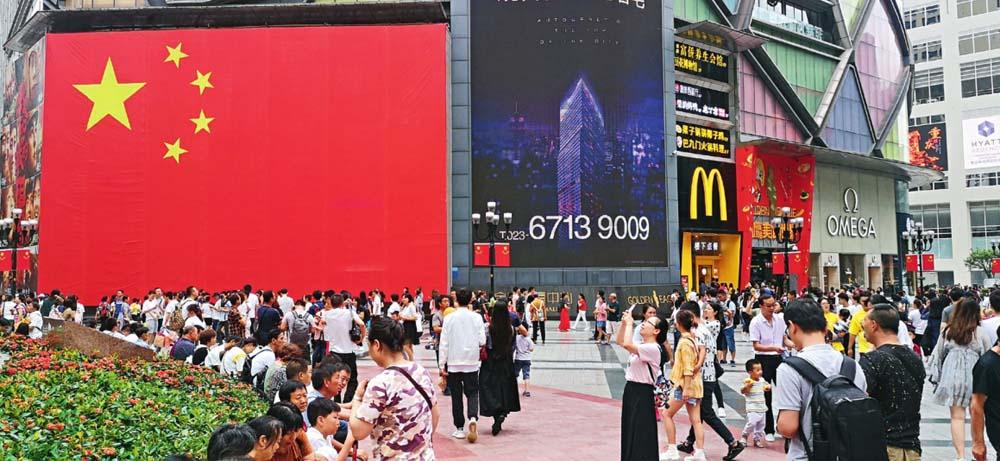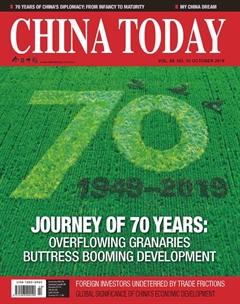Global Significance of China’s Economic Development
By CAI FANG

OVER the past seven decades since the Peoples Republic of China (PRC) was founded in 1949, China has emerged as the second largest economy in the world from a once poor country. While enabling its people to live a well-off life, China has also made prominent contributions to the worlds economic growth.
Why Is Chinas Experience in Development Important?
After the founding of the PRC, the Chinese economy embarked on a journey of independent development. On an economic foundation built over the first 30 years, China implemented the reform and opening-up policy in the following 40 years. In the process, institutional barriers of the planned economy were removed, and effective motivation mechanisms of a market economy have been put in place, enabling reallocation of resources. China has also participated in the global division of labor. Incorporating these efforts, China created an economic miracle never seen before in history while also making a prominent contribution to the worlds economic development.
Chinas current standing in the global economy is the result of the reform and opening-up over the last four decades and the explorations it made during the 30 years before the implementation of the policy. The founding of the PRC in 1949 saved China from the clutches of a semi-colonial and semi-feudal society and enabled it to develop as an independent country. China restored its economy from social unrest, improved peoples livelihood, and substantially reduced mortality rate. As for the population growth pattern, the country evolved from a phase featuring high fertility and mortality rates and a low natural growth rate to a phase characterized by high fertility, low mortality, and high growth rate. That shift was inevitable for China to later come to the phase when fertility, mortality, and natural population growth rates are all low, and reap its demographic dividend for economic growth.
The complete industrial system the country built in the first 30 years after the PRC was founded laid a foundation for industrial restructuring and effective resource allocation during reform and openingup. The newly founded PRC prioritized heavy industry in national development. This was a rational choice under the historical conditions at the time. Facing development bottlenecks brought about by the economic blockade by Western countries, China had to depend on its heavy industry. Admittedly, its economy failed to catch up to developed nations and fell further behind during those three decades.
In fact, due to the dichotomy of the global economic system as a result of the Cold War, that round of so-called globalization was restricted to a certain scope. In the 1990s, emerging economies and many countries transformed from planned economies adopted the policy of opening up and took part in the new round of economic globalization, which fundamentally changed the global economic landscape. China actively participated in this process and also benefited from this round of globalization. Within 40 years, it overtook many developed economies.
Entering the 21st century, China has increasing impact on the world economy with its high-speed growth rate, expanding economic size, and bigger share in the global economy. Besides material outputs, the country has been creating public goods for the international community, with its experience and development philosophies gained in reform and opening-up, as well as its increasing voice in shaping policies and constructive suggestions to development strategies.
China doesnt seek economic hegemony, nor export its development mode. However, as the worlds second largest economy, the largest industrial country, the biggest exporter of goods, and the country with the largest foreign exchange reserves, China is duty-bound to be a voice for itself and other developing countries, especially emerging economies, concerning international economic and trade policies, while also leading the efforts in improving the approach to global governance.
China had been contributing more than 10 percent to global economic growth since 1990. This figure held steady at around 30 percent after the 2008 global financial crisis. When compared with other regions, Chinas economy maintains stable growth and plays an increasingly prominent role in stabilizing the worlds economy.
The global economy would have been totally different without the high growth achieved by China. The growth rate variance of the global economy without China far outnumbers that including China. As the Chinese economy continues expanding and stabilizing, its role in fortifying the global economy is becoming increasingly prominent.
The growth of emerging economies and developing countries, largely led by China, makes the theory of global economic convergence a reality. From 1978 to 2017, the share of low-income and middle-income countries in global GDP rose from 21.3 percent to 35.3 percent, whereas the proportion of Chinas GDP in the total volume of low-income and middle-income nations jumped from 5.3 percent to 36 percent. During this period, in terms of constant prices, the total economic volume of all low-income and middle-income countries quadrupled. Among them, China contributed as much as 43.6 percent.
As a result of global economic convergence, the average income per capita in developing countries rose significantly, and the population living in absolute poverty and the headcount poverty ratio across the world dropped by an unprecedented extent. With the overall improvement of household incomes in both rural and urban areas brought by reform and opening-up, China lifted hundreds of millions of people out of poverty and made great contributions to the global poverty reduction efforts. The World Bank estimated that the number of extremely poor people, those who live on US $1.90 a day or less, had fallen by 1.14 billion from 1981 to 2015. This means more than 60 percent of people living in extreme poverty were lifted out of distress. Of the total number, 76.2 percent were able to live a better-off life in China.
Decoding Chinas Success
Before the adoption of the reform and opening-up policy, China distanced itself from Western countries and international organizations, and explored its path to development independently. After the policy was implemented, China established partnerships with multinational agencies, like the World Bank, by engaging in global trade, introducing foreign investment into the country, and encouraging its businesses to go global.
Since the inception, China has never adopted previous dogmas, or copied established development paths or so-called consensus. Instead, the country has implemented progressive reform by the principle of inclusive development, for the fundamental purpose of improving productivity, composite national strengths, and the peoples livelihood.
Chinese characteristics do not mean its development path is exclusive to China. In retrospect, Chinas reform and opening-up shows the logic behind its development and the three necessary steps and conditions to catch up to developed nations.
The first step was the introduction of an appropriate incentive mechanism. After the PRC was founded, to keep the price of agricultural products at a low level for industrial development, a priority of the national economy at that time, China adopted a state monopoly on the purchase and marketing of agricultural products. Accordingly, the country established communes, where people worked collectively and shared the welfare, and introduced the household registration system across the nation to retain productive factors and labor forces for agriculture. The system resulted in misallocation of resources and poor productivity of the agricultural sector. The lack of incentives seriously impacted the economy before reform and opening-up started.
New Contributions to Global Economic Growth
The 70-year history of the PRC is a journey of exploration and innovation. Whether achieving success or dealing with setbacks, they are valuable lessons and experience, which can be shared with other developing countries. Based on its accumulated experience, China is expected to continue its development on the path of reform and opening-up toward the goals it has set and make greater contributions to the world.
The first goal is upgrading economic growth drivers. As the Chinese economy goes through the Lewis turning point, meaning the surplus rural labor reaches a financial zero, and the demographic dividends diminish, the stage of dualistic economy will end. Economic growth will be more dependent on the productivity increase driven by skilled labor forces, competition based on market rules, and technological innovation.
To avoid the middle-income trap, China needs to deepen economic institutional reform in all respects. The advancement of reform will increase potential economic growth rate. Given the effects of reform policies, Chinas potential growth rate is expected to outperform the global average and that of high-income countries like the U.S. in the foreseeable future.
The second goal is extending reform, opening-up and development to more regions and sectors. In Chinas case, the coastal areas first implemented the reform and opening-up policy and realized economic growth. Amid widening regional disparities, two mechanisms played a mitigating role. The first is the market rules. A booming manufacturing sector in the coastal regions created great demands for labor, attracting the inflow of rural surplus labor from the central and western regions. Rural residents income and the overall productivity were increased as a result.
The second is based on government policies and strategies boosting the economy. Initiatives for regional coordinated development, like those for Chinas vast western regions, have helped improve the infrastructure and business climate in central and western areas.
As the Chinese economy passes the Lewis turning point, labor shortage will become a more prominent problem in its coastal regions, which will further diminish the comparative advantages of their labor-intensive manufacturing industry. The central and western regions have the conditions to take over the relocated industries from the coastal regions. A model of the flying geese paradigm for domestic division of labor based on the comparative advantages of the coastal, central, and western regions is taking shape.
At the same time, China rolled out plans of regional integrated development like the building of the Guangdong-Hong Kong-Macao Greater Bay Area and the integration of the Yangtze River Delta Region. The plans aim to maintain the strengths of the manufacturing sector. The diminishing comparative advantages of Chinas labor-intensive industries necessitate the forming of a flying geese paradigm for the international division of labor. In other words, the production of some goods should move from China, which sees rising labor costs, to neighboring countries or African economies where labor is abundant. The Belt and Road Initiative is implemented with infrastructure projects as the focus of efforts. Based on this, some industries will be transferred. The pattern is in line with the flying geese paradigm and has proven to be successful by Chinas domestic practice.
Last but not least, China deepens reform and opening-up by the principle of shared and inclusive development. Nations across the world pursue economic progress not for development per se, but for the peoples wellbeing. The reason why reform and openingup has been embraced by the Chinese people is because it puts the peoples wellbeing as the ultimate goal. This is also the secret for Chinas success over the past four decades.

